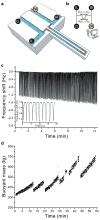Using buoyant mass to measure the growth of single cells
- PMID: 20383132
- PMCID: PMC2862099
- DOI: 10.1038/nmeth.1452
Using buoyant mass to measure the growth of single cells
Abstract
We used a suspended microchannel resonator (SMR) combined with picoliter-scale microfluidic control to measure buoyant mass and determine the 'instantaneous' growth rates of individual cells. The SMR measures mass with femtogram precision, allowing rapid determination of the growth rate in a fraction of a complete cell cycle. We found that for individual cells of Bacillus subtilis, Escherichia coli, Saccharomyces cerevisiae and mouse lymphoblasts, heavier cells grew faster than lighter cells.
Conflict of interest statement
COMPETING FINANCIAL INTEREST
The authors declare competing financial interests.
S.R.M. isaco-founder of Affinity Biosensors and declares competing financial interests.
Figures



Comment in
-
Measuring the growth rate of cells, one at a time.Nat Methods. 2010 May;7(5):363. doi: 10.1038/nmeth0510-363. Nat Methods. 2010. PMID: 20431549 No abstract available.
References
Publication types
MeSH terms
Grants and funding
LinkOut - more resources
Full Text Sources
Other Literature Sources
Molecular Biology Databases

